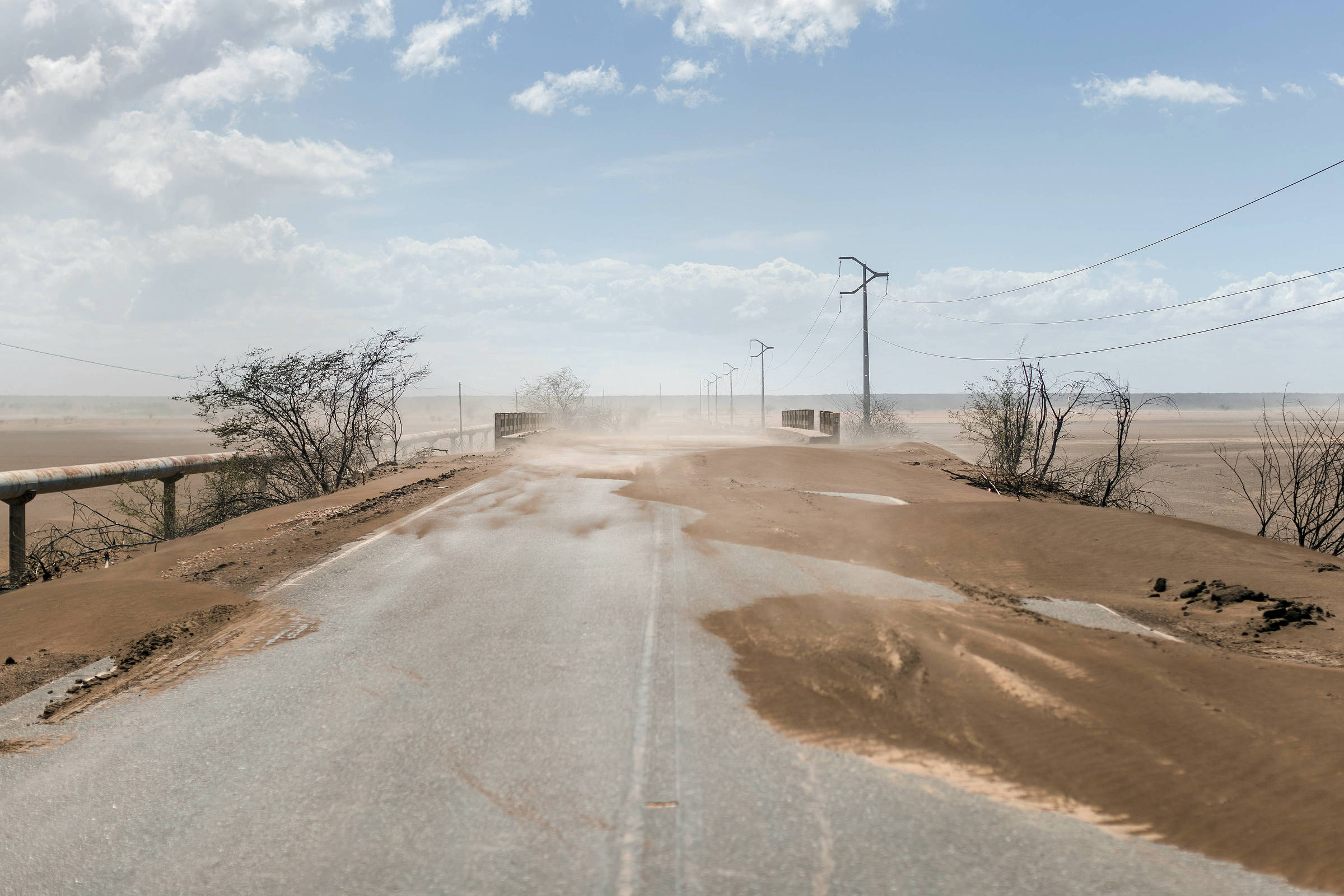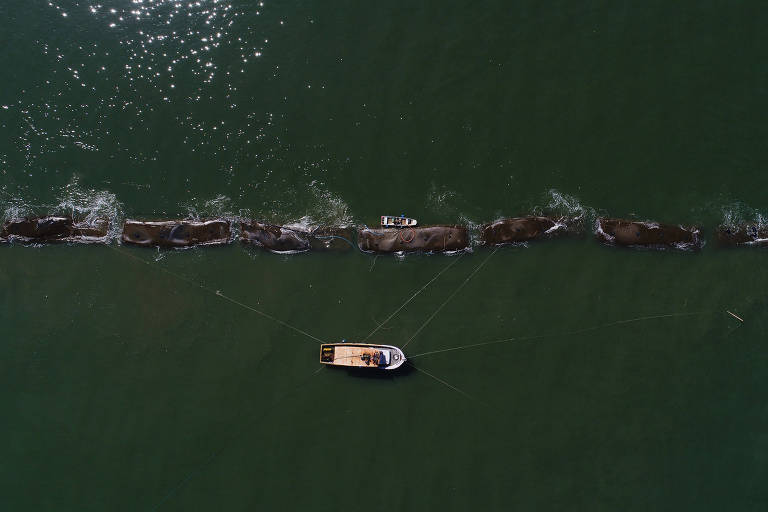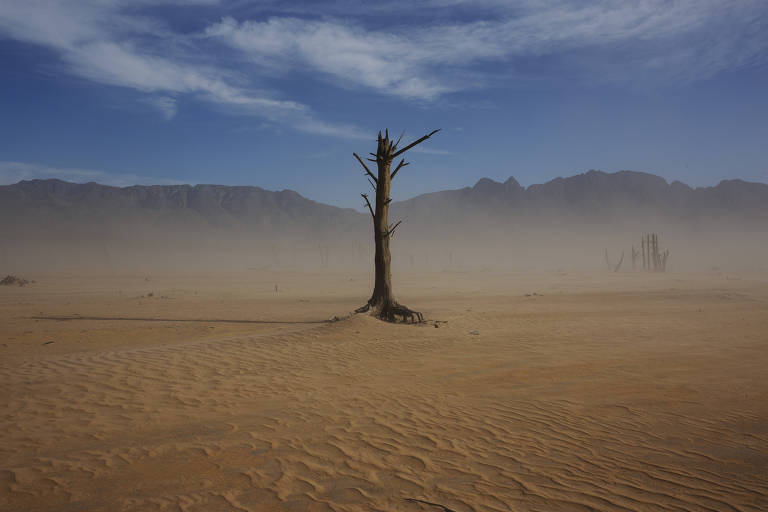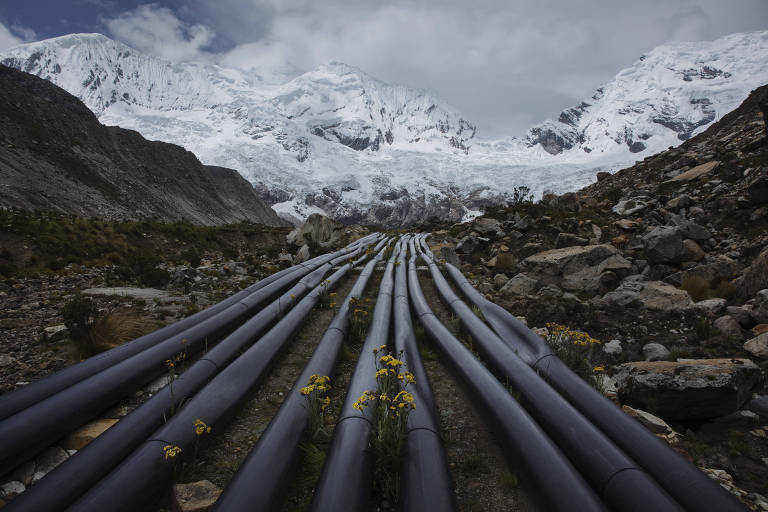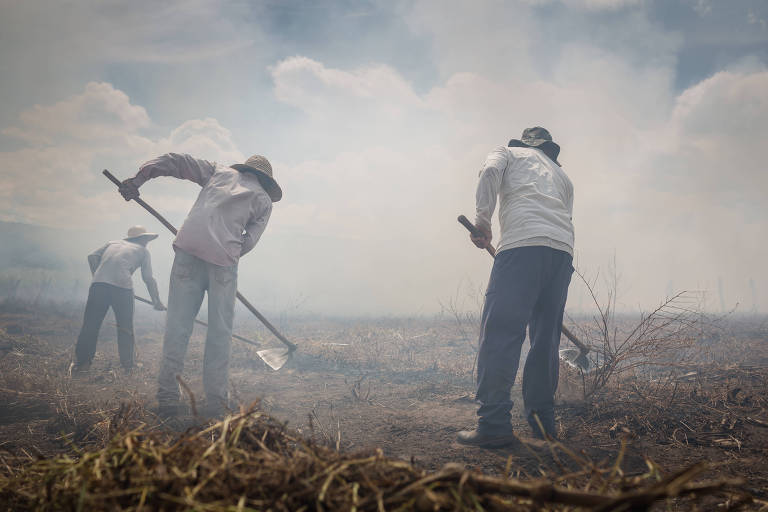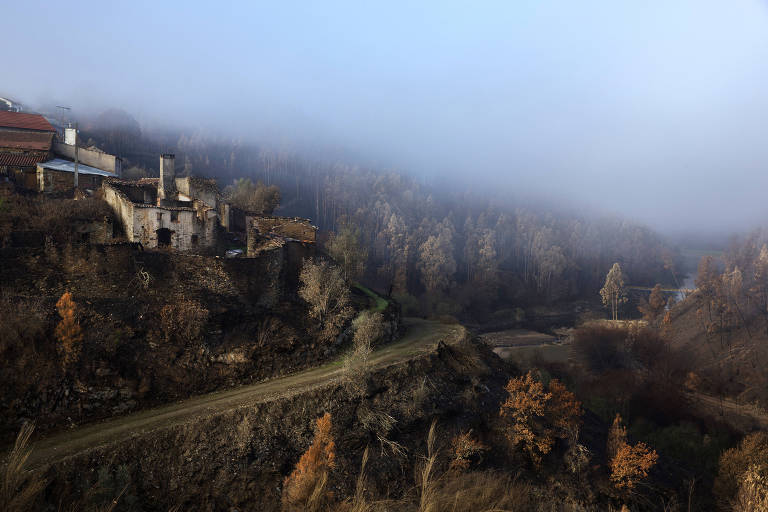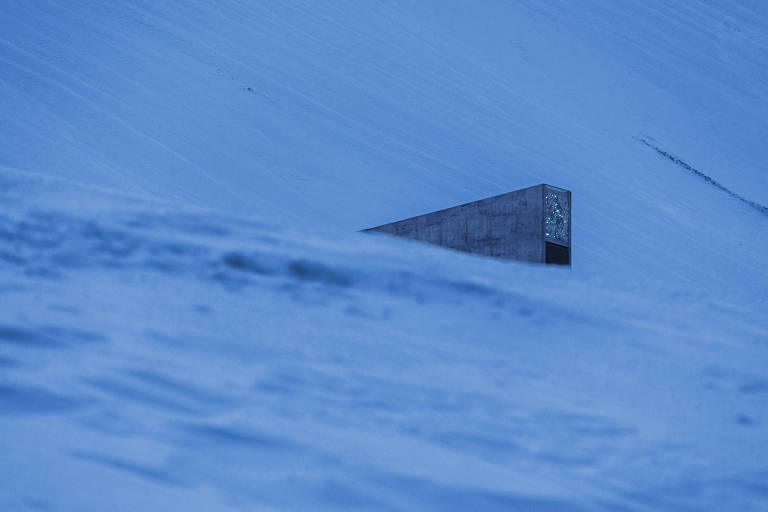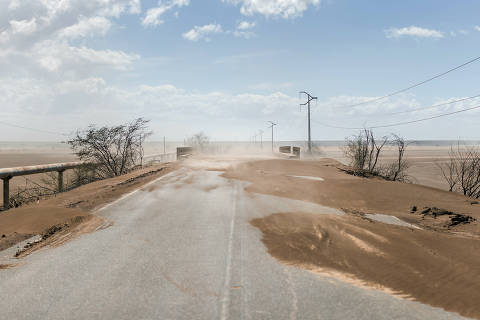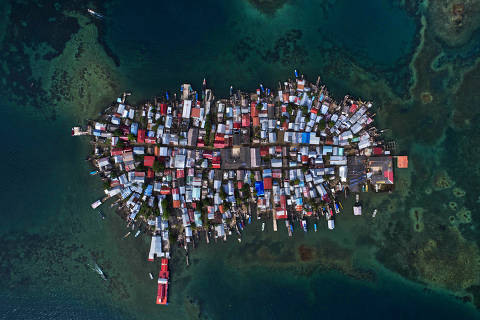Historical drought already lasts six years and threatens to become rule in the semi-arid
{{video=1}}
{{lang=1|por,//arte.folha.uol.com.br/ciencia/2018/crise-do-clima/nordeste/|esp,//arte.folha.uol.com.br/ciencia/2018/crisis-del-clima/nordeste/}}
Back to square one. It's how 73-year-old farmer Manuel da Silva has been feeling since drought decimated the coconut grove where he has worked for 44 years. Silva, a resident of Sousa (about 275 miles from Paraíba's capital city of João Pessoa), used to harvest 21 thousand coconuts every 45 days from a ten-acre plot, an area roughly the equivalent of five soccer fields. "If I had any left, you and I would be enjoying a nice coconut water today," he says.
According to Silva and other residents of this arid, outback region in Brazil's Northeast, the present dry stretch began in 2012, making it the longest drought in memory. Researchers' climate models suggest that the current water deficit will become the "new normal" for the region, spurred by global climate change.
Forecasts for the semi-arid region conducted by the Brazilian Climate Change Panel (or PBMC, using the Portuguese acronym), a government initiative, are bleak. The PBMC projects a 10 to 20 percent reduction in rainfall and temperature increases of 0.5 to 1 degree Celsius (0.9 to 1.8 degrees Fahrenheit) by the year 2040. By 2070, the change will be even more pronounced, with 25 to 35 percent less precipitation and a rise in temperature of 1.5 to 2.5 degrees Celsius (2.7 to 4.5 degrees Fahrenheit) projected for the region.
This scenario raises the risk of increased desertification and is exacerbated by detrimental land use practices, such as the deforestation of caatinga (a type of dryland vegetation) for firewood.
{{imagem=2}}
In addition to becoming drier, the semi-arid region is expanding. In November 2017, Brazil's Northeast Development Authority (SUDENE) classified 73 new municipalities as part of the growing semi-arid region, an area of 1,130,446 km² (436,467 square miles). It now makes up 13.3% of Brazilian territory. The total number of 1,262 semiarid municipalities is spread throughout the Northeastern states, as well as in parts of Minas Gerais, in the Southeastern part of the country.
For a city or town to be considered part of the semi-arid region, it must meet at least one of three criteria. The one most commonly applied is that average rainfall must be at or below 800 mm (31.5 inches) per year. As a point of comparison, the city of São Paulo receives an average of 1,500 mm (59 inches) of rain annually. Semi-arid classification can make municipalities eligible for a number of government programs, including access to credit lines.
Experts are divided on whether the six years of drought in the Northwest is connected to climate change. Some insist there is a causal link, while others deem it too early to make a definitive causal claim.
However, there is a much clearer consensus when it comes to the decades ahead. One example is a recent study by the Getúlio Vargas Foundation (FGV), conducted in the Piancó-Piranhas-Açu river basin in the Paraíba and Rio Grande do Norte outback, one of Brazil's most arid regions.
{{info=1}}
By 2065, the accumulated water deficit will be as much 133% higher than when compared to models that do not consider climate change, and it will affect a 43,600 km² (16,800 square mile) basin, an area the size of the state of Rio de Janeiro.
In order to better understand the increasingly dry Northeastern region, Folha de S.Paulo traveled nearly 500 km (310 miles) along the northern part of the basin, an extremely arid area home to more than 1.4 million people.
In the cities and rural communities mapped in the FGV study, Folha found nearly-depleted dams and water taps, stressed desert vegetation, farmers suffering from heavy losses, dead cattle and a great deal of apprehension about the trans-basin diversion of the nearby São Francisco River, a project expected to bring much-needed water to the area.
{{info=2}}
Local legend has it that while on a trip to Brazil, the American singer Madonna developed such a liking for coconut water from the Irrigated Perimeter of São Gonçalo (in Sousa, Paraíba) that the pop star had it imported in bulk. Others say that its reputation for being the sweetest coconut water in the Brazil inspired a series of knock-offs based on the original brand.
But all of this is now a thing of the past. Irrigation channels that were previously fed by the Piranhas River via the Gonçalo Dam are now bone dry and beyond repair, due to lack of maintenance. Engineered in the 1970s by the National Department of Drought Works (DNOCS), the irrigation system supported agriculture in an area of 4,000 hectares (nearly 10,000 acres) until the recent drought.
Today, a small number of green coconut trees remain, surviving near the few viable artesian wells. (Each tree draws an estimated 200 liters of water daily.) They are oases in the middle of abandoned fields, where ghostly husks and fallen trunks now prevail.
"Some people migrated to Brasília, some to São Paulo," says 33-year-old Isaías Raimundo, president of a local cooperative. "Some have temporary jobs and others survive with the help of parents who have retirement benefits."
Raimundo estimates that among the 82 members of his cooperative, only five percent of the coconut trees have survived. On his family's three-hectare (7.4 acre) plot, not a single one of the 600 trees survived. "I recently planted half a hectare (1.2 acres) of banana saplings and these are nearly all dead as well," he laments.
According to FGV, the Piancó-Piranhas-Açu basin has suffered economic losses of R$ 3 billion (about $880 million) due to the five-year drought, or about 3.1% of the region's GDP.
{{mosaico=1}}
Closer to the river's mouth in Rio Grande do Norte, farmers from the Novo Pingos settlement in Assu lost all of the cashew trees on a 500-hectare (1,235 acre) plot. They tried to minimize the loss by cutting the dead trees and selling them for firewood.
The good news is that water security in the region should soon improve. After a six-year delay, the Ministry of National Integration says it will complete its work on 260km (162 miles) of the North Fork of the São Francisco River diversion, which will feed the Piancó-Piranhas-Açu basin. For São Gonçalo, this will mean more water for the dam and a lifeline for the Piranhas River.
The East Fork was completed in March 2017, stabilizing the water supply of dozens of cities in Pernambuco and Paraíba, including Campina Grande (PB), whose reserves were on the verge of collapse.
However, the FGV study determined that the inter-basin diversion, with an estimated R$ 9.6 billion ($2.8 billion) price tag, is not a panacea for the Piancó-Piranhas-Açu basin's woes. Even with the expected influx of water, the São Francisco will only have the potential to reduce the area's water deficit by 40% in the most optimistic of scenarios.
"In an emergency, river diversion can be a sound option if it's done properly," says environmental engineer Layla Lambiasi, a co-author of the study. "But, in the long run, no single measure can entirely remedy the problem. Reducing drought damage will only be possible through coordinated actions that give resilience to local water systems."
{{imagem=1}}
With more than four decades of experience in the area, retired farmer Inácio da Silva believes that even with additional water, farmers will not have enough money to put into replanting coconut trees, which take an average of 3.5 years to produce.
"We're back to square one," says Silva. "The land is bare, and no one is producing. There's no work. The old men are retired, and the children are depending more and more on us because the soup pot has to boil for everyone."
49-year-old Francisco, one of Silva's seven sons, spent 15 years hauling coconuts from Sousa to Recife and Brasília. With no source of income, he sold his truck and now dreams of migrating to Guarujá, a coastal community in São Paulo state. "That's my profession now," he says with a bitter smile, pointing to some chickens in the yard.
{{imagem=5}}
{{video=2}}
{{imagem=13}}
87 miles from Sousa, São José de Piranhas is another parched city waiting for a reprieve from the São Francisco River.
Water pumps have only been operating three days a week in recent months. On February 12, the municipal dam collapsed for the second time since the beginning of the drought, leaving the city's 20,000 residents dependent on water trucks for their potable water supply. The water system was only reconnected in early March, after heavy rains in the region.
Soon, São José de Piranhas should start getting its water supply from the neighboring Boa Vista reservoir (8.7 miles from town), which will be fed by the São Francisco River. Before this can happen, however, an aqueduct still needs to be constructed.
37-year-old José Justino da Silva lives in the Rabo da Gata district of Piranhas and has been without running water since September 2017. That's when the Paraíba Water and Sewer Company (CAGEPA) suspended rationing for three days during Micaranhas, a popular seasonal festival in São José de Piranhas.
"There was plenty of water then [during the festival]. I've lived here for years and I had never taken a proper shower before," recalls Silva from the doorway of his low-ceilinged house after retrieving a bucket of water from the water truck.
After the festival revelry ran its course, rationing became even more severe and the neighborhood water pipes dried up definitively. Now water is only available from city and Army water trucks, or through private sellers, who charge R$ 30 ($9) per 1,000 liters.
But, even without water, the utility bills keep coming. In January, Silva shelled out R$ 40.84 (about $12) for the air in his pipes, instead of water. He said he prefers to pay than risk being cut off from the grid, as reconnecting the service would cost him about R$ 90 ($26.50).
Near the Boa Vista reservoir, the anticipation is also high. Cicero Fernandes has essentially had his life and work on hold in the two years since he left the site. The area will be entirely submerged when the dam receives water from the diverted river, so the 39-year-old farmer has relocated to one of four farming villages constructed for resettlement.
Fernandes and other farmers are entitled to 7-hectare (17 acre) lots, of which only one hectare will be irrigated. The rest will be dependent on rainfall.
Resettled families receive a monthly stipend equivalent of one-and-a-half times the minimum wage, until the irrigation project is fully completed. Fernandes says this is enough to get by, but points out that families outside the new farming settlements are faring much worse.
Many resort to seasonal work as sugarcane cutters in São Paulo state or as furadinhas, mobile clothing vendors in the streets of Maranhão and Pará. The term has its origins in the name for small pieces of paper used in lotteries for different products. Over time, the vendors changed the raffle tickets for clothing, but the name stuck.
"It has become even more difficult," says Fernandes. "With each passing year, we see more human and animal suffering. But sertanejos [people of the Brazilian outback] are tough, creative and persistent. We excel at stubbornness, and it will all work out in the end."
{{imagem=10}}
Rondynelli Dias, a local coordinator of CAGEPA, the Paraíba Water and Sewer Company, says the municipal dam "bled" (overflowed) for the last time in 2011. Since then it has been inching closer to empty. When Folha de S.Paulo visited the city at the beginning of January, it was at 1.6% of capacity. With rains in early March, the levels creeped up to just above 20%.
Used to being grilled by residents while making his rounds through the streets, Dias says that CAGEPA intends to conduct an audit in order to identify any improper billing of water accounts.
The sustained drought is just one of many problems facing the Piranhas River, the principal artery of the basin. The waterway's flow is now so feeble, it can no longer reach the sea.
In São Bento (242 miles from the state capital of João Pessoa), sewage flows openly toward the river bed. The municipality is the largest on the river, but only 57% of the sewage produced in the city is collected through pipes.
"It's no use [for the river] to get clean water from the São Francisco if it's just going to get contaminated with sewage," says former city councilor Josué Diniz de Araújo, 69, a member of the Piancó-Piranhas-Açu River Basin Committee.
{{video=3}}
{{mosaico=2}}
And then there are the disputes over the water itself. The most notorious case is in the Pendências region near the coast, pitting residents against shrimp farmers.
45-year-old Ana Lucia de Souza, a former river fisherman, says residents blame shrimp companies for overusing water, yet the shrimp farming industry is the principal source of employment in the municipality. "If it weren't for these companies," she explains, "I don't know how we would make ends meet. It's giving up one thing for another."
A native of the region, Souza says the river was different before, full of water and fish. "It was a beautiful thing," she recalls. "Today, it just makes me sad. We only see bush."
Because the basin crosses several state lines, the National Water Agency (ANA) is responsible for managing the area, but it cannot intervene to solve the problem of urban sewage. Carlos Perdigão, coordinator of water resources planning for the ANA, says the agency's priority is to improve water distribution in the semi-arid region.
{{info=3}}
In addition to completing the river diversion project, Perdigão says that finishing work on the Oiticica Dam in Jucurutu (Rio Grande do Norte) will be essential, as is construction of an extension to bring water to the Seridó region (in Paraíba and Rio Grande do Norte), another area faced with desertification.
FGV maintains that it will be necessary to go above and beyond river diversion strategies in order to stave off economic losses that could reach R$ 7.8 billion ($2.3 billion) over the next 50 years. "The more diversified the set of interventions," Lambiasi observes, "the less exposed the region will be to climactic events."
The study advocates the practice of "uncertainty management" as a means of minimizing the likely impacts of climate change. Suggested measures include the reduction of losses in water transit between reservoirs and identifying economic activities and practices more in line with conditions in semi-arid regions.
The researchers determined that if the government adopts the full set of recommendations, water deficit reduction could reach 73 percent and potential economic losses could be mitigated by as much as 93 percent.
Salomão Medeiros, head of the National Semi-arid Institute (INSA) for the past two years, says that one of the greatest challenges is getting the information generated by these types of studies into the hands of city managers. However, the technical jargon of the research and a lack of long-term planning on the part of municipalities can present challenges.
"There is also a cultural issue of ours," concedes the agricultural engineer. "The enduring hope that it will rain."
{{imagem=6}}
